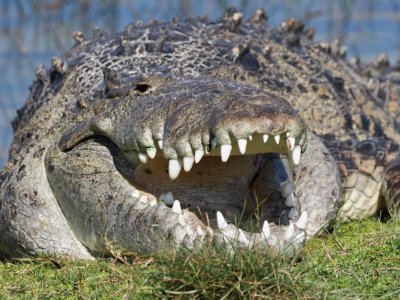Florida's infamous "Croczilla" has been captured, on camera, sunning himself by a pond in the Everglades.
Photographer Kymberly Strempack Clark, @kym_clark, had been searching for the colossal crocodile for months before finally stumbling upon him at Nine Mile Pond on Sunday afternoon.
"Every time I am at Everglades National Park, I look for Croczilla in hopes to get a glimpse of this enormous crocodile, rumored to be the largest in the park," Clark told Newsweek. "After many failed attempts in the past year, I looped through Nine Mile Pond on my way out of the park for a final check."



She continued: "I was shocked to see the infamous Croczilla, not at a distance but immediately in front of me on the shore, basking in the sun. The crocodile almost didn't look real."
According to the Florida Wildlife Commission, roughly 2,000 crocodiles reside in the state, compared with 1.3 million alligators. This is a significant improvement since the 1970s, when only a few hundred wild crocodiles were thought to exist in the U.S., although the species is still listed as being threatened.
Both American crocodiles and American alligators can be found in South Florida, the only place where both crocodilians are known to coexist. American crocodiles can grow up to 20 feet long, although they rarely exceed 14 feet in the wild. Croczilla is estimated to be a little over 14 feet.

"We don't know for sure [that it was him], but according to Everglades National Park employees and tour guides, Croczilla is seen occasionally at Nine Mile Pond and is the largest crocodile in the park," Clark said.
Nine Mile Pond is a popular spot for kayaking and canoeing, and Clark said several other vehicles were parked at the spot. These did not seem to deter the crocodile. "Croczilla was peacefully sunbathing on the bank, frequently opening its mouth to regulate its body temperature," Clark said.

Fixated on the crocodile, Clark stood for over an hour. "Mesmerized by this gigantic beauty and knowing I may never be graced with its presence again, I found it difficult to leave," she said.
However, she maintained a safe distance from the apex predator. "The general rule for most alligators and crocodiles is to remain about 20 feet from them, as they can lunge 6 feet from a resting position," she said.
Living in South Florida, she sees amazing wildlife, including alligators, every day. But a crocodile like this is a "rare and extraordinary find," she said. "To spot a crocodile this large makes the experience even more special because this is about the largest found in the wild in the U.S."
Uncommon Knowledge
Newsweek is committed to challenging conventional wisdom and finding connections in the search for common ground.
Newsweek is committed to challenging conventional wisdom and finding connections in the search for common ground.
About the writer
Pandora Dewan is a Senior Science Reporter at Newsweek based in London, UK. Her focus is reporting on science, health ... Read more





